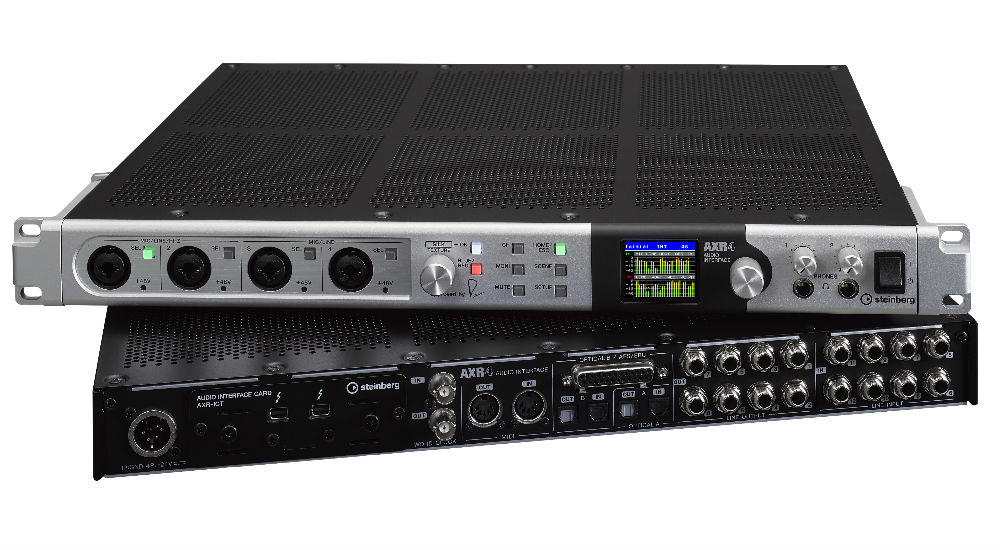The audio industry is progressing and advancing in leaps and bounds, and the AXR4 Thunderbolt 2 Audio Interface pulls no stops in slotting itself at the forefront of a lot of these new technologies. It’s Thunderbolt, so it’s some of the fastest data transfer available on the market, but also boasts the ability to record up to 32 bit/384kHz if and when required. There’s a couple of world-class preamps thrown in for good measure, and SSPLL jitter reduction technology. As if that weren’t enough, there’s AXR DSP mixing software, an extra mixing matrix before your DAW with further routing, audio processing and monitoring options. The AXR4 would serve literally any engineer on the planet well, but is priced to match. However, with all the features on board and inside the 1U unit, you may never need another interface.
The AXR4, despite the massive list of specs, flagship technologies and features, will only occupy one space in your rack. Therefore, when you inevitably buy a second, they’ll only collectively occupy two spaces. The AXR4 boasts a massive maximum of 28 inputs and 24 outputs if expanded fully via the D-sub or digital connections on the back of the unit. On the unit itself you’ve got four preamps, all with combo XLR/jacks and all four preamps feature emulations of the Rupert Neve Designed SILK processing found on more high end Rupert Neve Designs preamps and processors. The four onboard preamps have combo XLR/jacks for connecting mics or alternatively for connecting guitars, basses or keys directly and using plugins to record or simply monitor your takes, as the Thunderbolt 2 connecting offers ultra-low latency. The unit’s converters can be set up to 32-bit with a 384kHz sample rate, admittedly higher than usually required but it’s a whole lot of room for oversampling if and when necessary when processing ultra high-quality audio. The unit itself can be expanded with AES/EBU digital connections, or optical connections, or via analogue connections using the D-Sub option.
On board, with no expansion, there’s eight line inputs (in addition to the four preamps on the front of the unit, and eight line outputs. There’s MIDI in/out (to connect to your Steinberg MIDI controllers to use Steinberg’s range of soft synths), a word clock I/O and dual thunderbolt I/O (for daisy chaining units together). It’s important to note, when mentioning the word clock I/O, that the AXR4 features SSPLL jitter reduction technology. In a nutshell, audio jitter is the deviation from the master clock source when discussing sample rates. For example, if a recording is occurring at 44.1kHz (or 384kHz as the monstrously powerful AXR4 can muster), then every digital piece of the signal chain must be clocked and locked to the same sample rate, or the samples won’t line up. Jitter is the audible effect of the deviation when things don’t clock properly. Even when units are clocked, jitter can still occur because of a variety of variables in your system. SSPLL jitter reduction technology is currently the most advanced anti-jitter technology for audio, and the AXR4 has it on board.
In use, the AXR4 is a breeze, and a pleasure. The onboard preamps on interfaces are usually fairly uncoloured, and for good reason. You want a nice transparent preamp to colour with other tones or another preamp or plugin. But I’ve got to say, the Rupert Neve Designs SILK feels good. You don’t have to use it, but it’s a nice option to have on board. For those playing at home, the SILK function is a pleasing harmonic distortion that can be blended in to taste. Sounds become more present and sizeable, but never overbearing. The preamp acts in the same way a preamp may act with a hot signal, without having to push the signal.
The SILK in Rupert Neve Designs products is analogue emulation of an analogue effect, while the SILK on the AXR4 is a digital emulation so accurate that Rupert Neve Designs have put their name to it. And you get four of these preamps on the unit itself. Don’t need it? Don’t use it all the time, but they’re there and that’s worth the investment in itself. Beyond the hardware preamps, the AXR4 features AXR DSP mixing software – a 28/24 mixing matrix that can be used to process plugins and sounds using DSP instead of your computer’s processing power. The plugins themselves repowered by onboard DSP, and because they’re pre-DAW, they’re latency free. There’s a bunch of great stuff from Yamaha such as their EQ 601, the stereo Classic Compressor 276, a channel strip and REV-X Reverb.
Overall, the AXR4 is a monstrous audio interface that I still can’t believe is packed into a 1U unit. There’s twelve inputs on board, and eight outputs. There’s options to expand it further but you mightn’t need to. You’ve got four preamps ready to be coloured externally or in one unit with the Rupert Neve Designs SILK emulation on all four of the preamps on the front plate. Once you’ve got signal, you can process audio latency free via the AXR DSP processing and Steinberg plugins of famed Yamaha gear. All this, virtually jitter free. The AXR4 is your next interface, but its also the interface you’ll be using in ten years. A solid investment for a stellar piece of gear.

